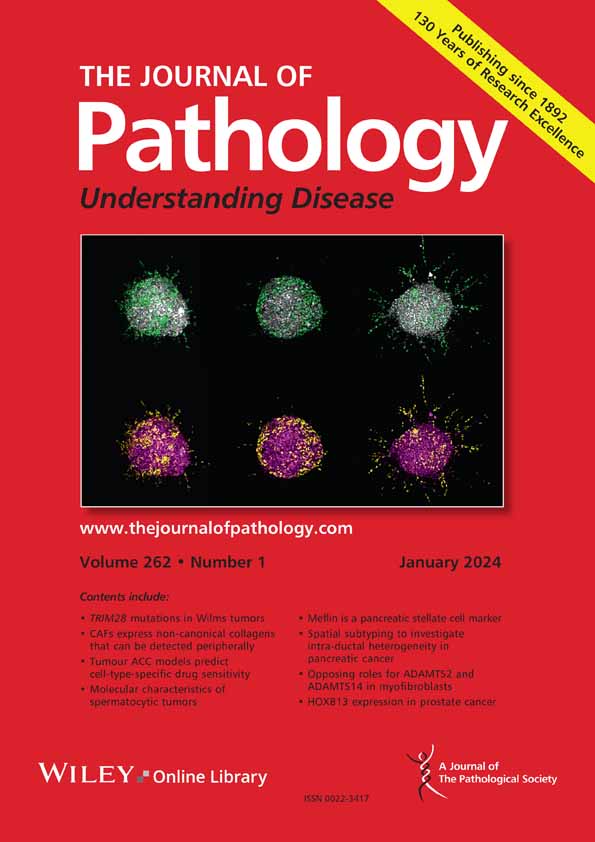Yasunobu Mano, Keisuke Matsusaka, Motoaki Seki, Kazuko Kita, Masaki Fukuyo, Bahityar Rahmutulla, Genki Usui, Ryoji Fujiki, Masayuki Urabe, Hiroyuki Abe, Hisahiro Matsubara, Tetsuo Ushiku, Yasuyuki Seto, Masashi Fukayama, Atsushi Kaneda
求助PDF
{"title":"dna高甲基化的人胃癌在没有TP53突变的情况下绕过细胞凋亡。","authors":"Yasunobu Mano, Keisuke Matsusaka, Motoaki Seki, Kazuko Kita, Masaki Fukuyo, Bahityar Rahmutulla, Genki Usui, Ryoji Fujiki, Masayuki Urabe, Hiroyuki Abe, Hisahiro Matsubara, Tetsuo Ushiku, Yasuyuki Seto, Masashi Fukayama, Atsushi Kaneda","doi":"10.1002/path.6480","DOIUrl":null,"url":null,"abstract":"<p><p>p53 is one of the most important tumour suppressors exerting antitumour effects primarily via apoptosis. TP53 mutations are common in gastric tumorigenesis; however, nearly half of the gastric cancers (GCs) remain wildtype TP53 (TP53_WT). We investigated epigenetic/genetic profiles of GCs and the carcinogenic mechanisms underlying GCs with TP53_WT. Comprehensive DNA methylation analysis revealed four DNA methylation epigenotypes (MEs) in GCs, namely, high ME (HME), extremely HME (E-HME), low ME (LME), and extremely LME (E-LME). E-HME matched Epstein-Barr virus (EBV)-positive GC (E-HME/EBV). HME can be further categorised into MLH1-deficient (HME_MLH1(-)) and -proficient cases. The Cancer Genome Atlas data confirmed that HME_MLH1(-)/microsatellite instability (MSI) and E-HME/EBV cases significantly retained TP53_WT and had higher MDM2 expression levels than other MEs. We hypothesised that apoptosis pathways in TP53_WT GC may be suppressed post-transcriptionally by activated MDM2. Short hairpin RNA-mediated MDM2 knockdown and the p53-MDM2 inhibitors, nutlin-3 and RG7388, induced apoptosis in TP53_WT GC cells, indicating that activated MDM2 suppressed p53 protein levels and thereby attenuated the downstream p53 pathway activation, which was restored upon MDM2 knockdown or inhibitor treatment. Collectively, DNA-hypermethylated GC cases, HME_MLH1(-)/MSI and E-HME/EBV, follow a unique carcinogenic pathway to evade apoptosis in the absence of TP53 mutation, potentially making them responsive to therapeutic strategies that function primarily through the p53 pathway. © 2025 The Pathological Society of Great Britain and Ireland.</p>","PeriodicalId":232,"journal":{"name":"The Journal of Pathology","volume":" ","pages":""},"PeriodicalIF":5.2000,"publicationDate":"2025-10-09","publicationTypes":"Journal Article","fieldsOfStudy":null,"isOpenAccess":false,"openAccessPdf":"","citationCount":"0","resultStr":"{\"title\":\"DNA-hypermethylated human gastric cancer circumvents apoptosis in the absence of TP53 mutation.\",\"authors\":\"Yasunobu Mano, Keisuke Matsusaka, Motoaki Seki, Kazuko Kita, Masaki Fukuyo, Bahityar Rahmutulla, Genki Usui, Ryoji Fujiki, Masayuki Urabe, Hiroyuki Abe, Hisahiro Matsubara, Tetsuo Ushiku, Yasuyuki Seto, Masashi Fukayama, Atsushi Kaneda\",\"doi\":\"10.1002/path.6480\",\"DOIUrl\":null,\"url\":null,\"abstract\":\"<p><p>p53 is one of the most important tumour suppressors exerting antitumour effects primarily via apoptosis. TP53 mutations are common in gastric tumorigenesis; however, nearly half of the gastric cancers (GCs) remain wildtype TP53 (TP53_WT). We investigated epigenetic/genetic profiles of GCs and the carcinogenic mechanisms underlying GCs with TP53_WT. Comprehensive DNA methylation analysis revealed four DNA methylation epigenotypes (MEs) in GCs, namely, high ME (HME), extremely HME (E-HME), low ME (LME), and extremely LME (E-LME). E-HME matched Epstein-Barr virus (EBV)-positive GC (E-HME/EBV). HME can be further categorised into MLH1-deficient (HME_MLH1(-)) and -proficient cases. The Cancer Genome Atlas data confirmed that HME_MLH1(-)/microsatellite instability (MSI) and E-HME/EBV cases significantly retained TP53_WT and had higher MDM2 expression levels than other MEs. We hypothesised that apoptosis pathways in TP53_WT GC may be suppressed post-transcriptionally by activated MDM2. Short hairpin RNA-mediated MDM2 knockdown and the p53-MDM2 inhibitors, nutlin-3 and RG7388, induced apoptosis in TP53_WT GC cells, indicating that activated MDM2 suppressed p53 protein levels and thereby attenuated the downstream p53 pathway activation, which was restored upon MDM2 knockdown or inhibitor treatment. Collectively, DNA-hypermethylated GC cases, HME_MLH1(-)/MSI and E-HME/EBV, follow a unique carcinogenic pathway to evade apoptosis in the absence of TP53 mutation, potentially making them responsive to therapeutic strategies that function primarily through the p53 pathway. © 2025 The Pathological Society of Great Britain and Ireland.</p>\",\"PeriodicalId\":232,\"journal\":{\"name\":\"The Journal of Pathology\",\"volume\":\" \",\"pages\":\"\"},\"PeriodicalIF\":5.2000,\"publicationDate\":\"2025-10-09\",\"publicationTypes\":\"Journal Article\",\"fieldsOfStudy\":null,\"isOpenAccess\":false,\"openAccessPdf\":\"\",\"citationCount\":\"0\",\"resultStr\":null,\"platform\":\"Semanticscholar\",\"paperid\":null,\"PeriodicalName\":\"The Journal of Pathology\",\"FirstCategoryId\":\"3\",\"ListUrlMain\":\"https://doi.org/10.1002/path.6480\",\"RegionNum\":2,\"RegionCategory\":\"医学\",\"ArticlePicture\":[],\"TitleCN\":null,\"AbstractTextCN\":null,\"PMCID\":null,\"EPubDate\":\"\",\"PubModel\":\"\",\"JCR\":\"Q1\",\"JCRName\":\"ONCOLOGY\",\"Score\":null,\"Total\":0}","platform":"Semanticscholar","paperid":null,"PeriodicalName":"The Journal of Pathology","FirstCategoryId":"3","ListUrlMain":"https://doi.org/10.1002/path.6480","RegionNum":2,"RegionCategory":"医学","ArticlePicture":[],"TitleCN":null,"AbstractTextCN":null,"PMCID":null,"EPubDate":"","PubModel":"","JCR":"Q1","JCRName":"ONCOLOGY","Score":null,"Total":0}
引用次数: 0
引用
批量引用

 求助内容:
求助内容: 应助结果提醒方式:
应助结果提醒方式:


